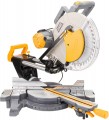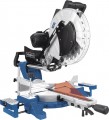Power
Saw motor power in watts. For petrol tools (see "Power Source"), horsepower is additionally indicated, see below for details.
The higher the power, the better the tool is suitable for voluminous work and hard materials, the greater the depth of cut it can provide and the easier it can cope with significant loads. In addition, for different types of saws and different types of materials, the actual power values \u200b\u200bcan also be different. For example, a power of
2.5 – 3 kW is actually the limit for
chain saws, but in
chain saws this is an average figure, among such tools there are models of
3 – 4 kW and even
more. Detailed selection recommendations for various cases can be found in special sources.
Saw angle
The largest angle at which the working part of the saw can be rotated relative to the standard position (note that we are not talking about tilt, but about turning from side to side). This feature is often found in miter saws (see Device) which are not limited to straight cuts; turning the saw is the most convenient, and sometimes the only way to cut the workpiece obliquely.
Guides
Miter saws have
a broach system, which, thanks to parallel rails, allows the saw blade to move relative to the desktop back and forth along the cut line. This facilitates work with workpieces of large width, but significantly affects the weight and dimensions of the entire structure. At the same time, the guides along which the rails move can be both frontal and rear. The first type makes the design more compact, since no elements stick out. The second type, at the expense of compactness, makes the design more reliable.
In box
- Disc. The presence of a saw blade is included in the delivery set of the circular tool. It can be either one or
several, which allows you to use the saw “out of the box” without the need to purchase additional consumables. If you already have a saw blade or intend to select it for specific tasks, it is worth taking a closer look at the configurations
without a blade - they are usually cheaper.
- Chain. One or
more chains included as standard with the saw. The presence of a chain with teeth for cutting allows you to do without purchasing a separate executive body for chain saw. However, there are configurations
without a chain - it is assumed that the customer already has a chain or he will select the required option himself.
— Saw blade. The presence of one or
more saw blades in the complete set of a reciprocating or band tool. They ensure that the saw is ready for use literally immediately after unpacking. There are also configurations of reciprocating or band models
without a saw blade - they are cheaper, and the customer has the right to choose a suitable blade independently.
—
Dust collector. A dust collector is included with the saw. The dust collector is a container for collecting sawdust and other d
...ebris generated during operation; As a rule, such a container is made removable. Installing a dust collector slightly increases the dimensions of the entire tool, but this is compensated by cleanliness and convenience: dust and other production waste mostly settle in the container and not on surrounding objects.
- Charger. The presence of a charging block in the package allows you to charge batteries. Accordingly, for models with batteries, this accessory is necessary to power the battery. However, there are models without a charger. And saw with it may differ in the charger model, the name of which will allow you to learn more about its characteristics and, if necessary or if required (breakdown), purchase a similar one.
— Case (bag). Availability of a case or bag included with the instrument. A case is a container-suitcase made of hard material; bags are usually made of soft material. This way the case provides maximum protection and the bag can be folded away compactly when not in use. The specific type of case that comes with the saw should be specified separately. However, in any case, a complete case or bag will be more convenient for storing and transporting the instrument than impromptu packaging.
- Stand. The stand makes the saw tool more stable, reliable and safe. The presence of a stand is typical for stationary type saw. Mostly these are powerful, productive, large and heavy models that are located in a separate place. The stand can be implemented either with classic legs (bed) or with a cabinet with a tool compartment. The stand can be equipped with various types of saw: circular saw, miter saw, band saw, cutting saw and even chain saw (with electric drive).
— Wheels for transportation. Transport wheels make it easy to move sawing equipment around the shop. The presence of wheels will come in handy when the saw needs to be moved a little to install some large workpieces or simply when cleaning the workshop. As a rule, wheels are typical for stationary saw with a table top or work holder.Size
General dimensions of the saw. For a stationary tool (see "Type"), this parameter determines primarily the amount of space that will be required for installation; problems with this can only arise in very tight spaces, so in most cases the dimensions of a stationary saw do not need to be given special attention. In the case of hand-held models, the small size makes it easier to work in hard-to-reach places and improves overall usability. On the other hand, a compact tool inevitably turns out to be low-power; and some jobs by definition require large, heavy saws, with large bar lengths or blade diameters.

